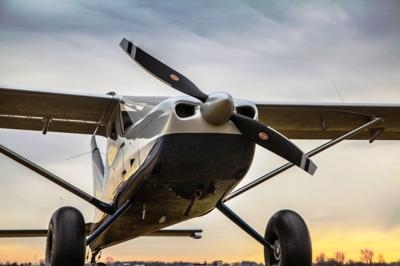Tue, Mar 18, 2014
Two- And Three-Blade Versions 'Designed To Maximize Performance' Company Says
Hartzell Propeller is introducing two- and three-blade versions of its new swept-tip Trailblazer prop for experimental aircraft and a number of certificated aircraft models.

“I put the new Hartzell Trailblazer prop on my Sportsman for increased performance that backcountry flying demands. Backcountry flying is all about getting into remote landing areas, but once you’re in you have to get back out,” said Hartzell Propeller President Joe Brown. “The takeoff acceleration and climb performance of the new Trailblazer prop gives me the added performance I want for backcountry flying.”
The new Hartzell Trailblazer swept-tip propellers are designed to maximize performance of the numerous aircraft, both certified and amateur built, specifically designed for bush and backcountry flying. The two-blade version is compatible with most Lycoming 360 and 390 series engines, with no placards or restrictions. A three-blade version is available for higher horsepower applications. In addition, Hartzell Propeller is working with numerous aircraft manufacturers to pursue approvals to install the new Trailblazer propeller on certified aircraft.
The two-blade configuration of the Hartzell Trailblazer propeller is available in 78”, 80” and 83” diameters and the three-blade configuration in 80”, 82” and 85” diameters. All have unlimited blade life and are approximately 20 percent lighter than comparable propellers with aluminum blades. The swept-tip, scimitar shaped airfoil is designed for optimal take-off acceleration and climb performance, resulting in an increase of 80-100 fpm climb rate versus a three-blade wood core propeller. The thin, stiff airfoil design that is possible when utilizing aerospace composites allows improved low speed thrust while achieving a three-knot cruise speed improvement over wood core props.
The Hartzell Trailblazer’s all carbon fiber construction features an innovative mesh erosion shield and field replaceable nickel-cobalt leading edge ensuring it can withstand demanding backcountry and bush flying. The carbon fiber structural composite construction is more than five to 10 times stronger than beech wood and spruce, respectively, and includes Hartzell’s state-of-art wedge shank blade retention design.
(Image provided by Hartzell)
More News
A Puff Of Smoke Came Out From The Top Of The Engine Cowling Followed By A Total Loss Of Engine Power On May 9, 2025, about 1020 mountain daylight time, an experimental amateur-buil>[...]
From 2022 (YouTube Edition): Jenny, I’ve Got Your Number... Among the magnificent antique aircraft on display at EAA’s AirVenture 2022 was a 1918 Curtiss Jenny painstak>[...]
Very High Frequency (VHF) The frequency band between 30 and 300 MHz. Portions of this band, 108 to 118 MHz, are used for certain NAVAIDs; 118 to 136 MHz are used for civil air/grou>[...]
“From approximately November 2021 through January 2022, Britton-Harr, acting on behalf of AeroVanti, entered into lease-purchase agreements for five Piaggio-manufactured airc>[...]
Microburst A small downburst with outbursts of damaging winds extending 2.5 miles or less. In spite of its small horizontal scale, an intense microburst could induce wind speeds as>[...]
 NTSB Prelim: Lee Aviation LLC JA30 SuperStol
NTSB Prelim: Lee Aviation LLC JA30 SuperStol Classic Aero-TV: Curtiss Jenny Build Wows AirVenture Crowds
Classic Aero-TV: Curtiss Jenny Build Wows AirVenture Crowds ANN's Daily Aero-Term (05.30.25): Very High Frequency (VHF)
ANN's Daily Aero-Term (05.30.25): Very High Frequency (VHF) Aero-News: Quote of the Day (05.30.25)
Aero-News: Quote of the Day (05.30.25) ANN's Daily Aero-Term (05.31.25): Microburst
ANN's Daily Aero-Term (05.31.25): Microburst



